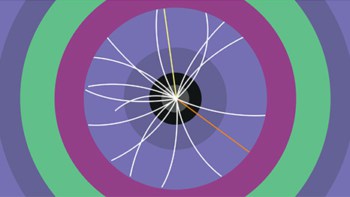
Novae – explosions of white dwarf stars – are among the most frequent and violent events in our galaxy. They are thought to play a key role in synthesizing heavy elements, but the mechanisms behind this stellar nucleosynthesis process are not fully understood. A new set of ultra-precise estimates of sulphur isotopes produced during astrophysical nuclear reactions promises to shed fresh light on this question by making it easier to identify traces of nucleosynthesis in ancient meteorites.
Novae occur in binary systems made up of a white dwarf and a main sequence star. In such systems, known as “cataclysmic variables”, the white dwarf’s gravitational pull distorts its companion star, causing stellar material to transfer to the white dwarf. As a result, the system becomes alternately brighter and dimmer until the white dwarf accrues enough matter to trigger a runaway thermonuclear reaction on its surface. The ensuing luminous explosion is energetic enough to fuse lighter atoms into heavier nuclei and eject them into space. Indeed, many elements found on Earth are thought to originate when a star very much like our Sun exploded in this fashion.
Large uncertainties in nuclear physics processes
Over the last 30 years or so, optical, ultraviolet and infrared observations of novae have provided detailed information about the chemical composition of the matter they eject. These observations have revealed that the nature of the explosion depends on the original composition of the white dwarf. For example, “oxygen-neon” novae produce especially massive explosions capable of creating elements as heavy as silicon and calcium.
More recently, researchers have also studied nova nucleosynthesis by isolating microscopic grains from primitive meteorites. These meteorites date from before the solar system’s formation, and their isotopic composition reflects the nucleosynthesis processes that took place in the parent star around which they formed.
Despite all the data available, however, some stages of nova nucleosynthesis are still not well understood. An example is the 33Cl(p,γ)34Ar astrophysical nuclear reaction, which produces heavy elements from two lighter “seed elements”, oxygen and neon, via a chain of proton captures and beta decays. Although the 33Cl(p,γ)34Ar reaction is known to determine the ratio of sulphur isotopes in grains of pre-solar meteorites, large uncertainties in several experimentally unconstrained nuclear physics processes make it hard to use isotope-ratio data to determine how a given meteorite formed.
Detailed gamma-ray spectroscopy of 34Ar
A team led by physicists from the Argonne National Laboratory in the US and the University of Surrey in the UK have now made the best estimates yet of the ratio of 32S/33S isotopes produced in the 33Cl(p,γ)34Ar reaction – a result they say can be used to identify the origin of presolar grains found in primitive meteorites.

Strontium detection confirms heavy elements form in neutron star mergers
The researchers obtained their results by bombarding a target of 12C with a 95 MeV beam of 24Mg ions produced by the ATLAS accelerator for 140 hours. This bombardment produced excited 34Ar, 34Cl and 34S nuclei, which then decayed by emitting gamma rays. Thanks to an array of detectors called GRETINA, the researchers were able to detect the gamma rays, analyse their energies and use this spectrum to determine which energy levels of 34Ar, 34Cl and 34S were involved in the 33Cl(p,γ)34Ar reaction.
Close to theoretically calculated values
“Our results point to 32S/33S ratios in some presolar grains that are close to theoretically calculated values for novae,” team member Dariusz Seweryniak tells Physics World. This, he adds, implies that ratios of other isotopes in these grains can also be used to constrain nova models and thus the creation of heavy metals in the universe.
The researchers, who report their work in Physical Review Letters, say their technique will be used in the near future to study other astrophysical reactions such as 59Cu(p,g) and 59Cu(p,a), which are also important for heavy element synthesis.



